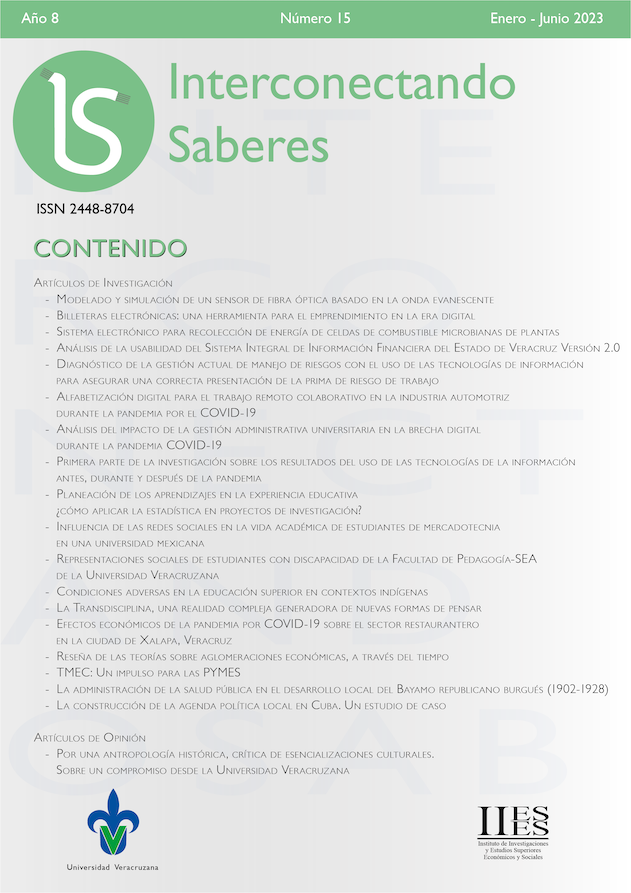Abstract
The results of the development of the Educational Experience (EE) are presented. How to apply statistics in research projects? (winter 2021 intersemester) taught in January 2022, through the implementation of a new planning and operation process caused by the COVID-19 pandemic. Appropriate learning routes were defined for the online modality. The Eminus 4 platform of the Universidad Veracruzana and Microsoft Teams were used for educational continuity. The relationship between the teacher/facilitator and students was evidenced through a didactic/dynamic process of learning and/or teaching, where creativity was sought to strengthen student competencies, promote student autonomy and the role of teacher guide. through teaching-learning practices. It will be modified that 100% of the students accredit the EE with a final work in the form of a scientific article in IMRAD format related to a social network.
References
De la Fuente Sánchez, .D., Hernández Solís, M., & Pra Martos, I. (2013). El Mini video como Recurso Didáctico en el Aprendizaje de materias cuantitativas RIED. Revista Iberoamericana de Educación a Distancia, 16 (2), 177-192.
Del Callejo Canal, D. D., Canal Martínez, M. E., & Hákim Krayem, M. R. (2022). Estrategias innovadoras de aprendizaje aplicadas en la Experiencia Educativa ¿Cómo aplicar la Estadística en proyectos de investigación?, integradas en las plataformas EMINUS 4 y TEAMS (Universidad Veracruzana). Interconectando Saberes, (13), 85-99. https://doi.org/10.25009/is.v0i13.2707
Delors, J. (1996). Los cuatro pilares de la educación. En La educación encierra un tesoro. Informe a la UNESCO de la Comisión internacional sobre la Educación para el siglo XXI. Madrid, España: Santillana/UNESCO. pp. 91-103.
Garfield, J., del Mas, R., & Chance, B. (2003). The Web-based ARTIST: Assessment Resource Tools for Improving Statistical Thinking. Paper Presented at the Annual Meeting of the American Educational Research Association, (April). https://publication/uuid/F567FA34-BCC6-49A2-A6EC-8BC6BC88BFDC
Gutiérrez-Delgado, J., Gutiérrez-Ríos, C. & Gutiérrez Ríos, J. (2018). Estrategias metodológicas de enseñanza y aprendizaje con un enfoque lúdico. Revista de Educación y Desarrollo. (45), 37 - 46. https://www.cucs.udg.mx/revistas/edu_desarrollo/anteriores/45/45_Delgado.pdf
Moreno Olivos, T. (2012). La evaluación de competencias en educación. Sinéctica, (39), 01-20. http://www.scielo.org.mx/scielo.php?script=sci_arttext&pid=S1665-109X2012000200010&lng=es&tlng=es.
Organización para la Cooperación y el Desarrollo Económicos (OCDE) (2019), Higher Education in Mexico: Labour Market Relevance and Outcomes, Higher Education, OECD Publishing, Paris. https://www.oecd.org/centrodemexico/medios/educacion_superior_en_mexico.pdf
Secretaría de Educación Pública (SEP) (2016). Modelo Educativo 2016. https://www.gob.mx/cms/uploads/attachment/file/114501/Modelo_Educativo_2016.pdf
Solano Fernández, I. M., & Sanchez Vera, M. M. (2010). Aprendiendo en cualquier lugar: El Podcast Educativo. Pixel-Bit. Revista de Medios y Educación, (36), 125-139.
Universidad Veracruzana [UV]. (1999). Nuevo Modelo Educativo para la Universidad Veracruzana. Lineamientos para el nivel licenciatura. Propuesta. https://www.uv.mx/dgdaie/files/2012/11/NME-Propuesta.pdf
Universidad Veracruzana [UV]. (2020). Pautas para la planeación flexible de Experiencias Educativas. México. https://www.uv.mx/plandecontingencia/files/2020/04/14-DGDAIE-Planeacio%CC%81n-Flexible-de-una-EE-DIE.pdf
Universidad Veracruzana [UV]. (2022b). Eminus 4. https://eminus.uv.mx/eminus/default.aspx?ReturnUrl=%2feminus%2f
Universidad Veracruzana [UV]. (2022c). Innovación educativa. https://www.uv.mx/dgdaie/innovacion-educativa/#:~:text=La%20innovaci%C3%B3n%20educativa%20es%20un,el%20fin%20de%20promover%20aprendizajes
Universidad Veracruzana [UV]. (2022d). Coordinación de Aprendizaje basado en problemas. Introducción. https://www.uv.mx/abp/introduccion/
Universidad Veracruzana [UV]. (2022a). Sistema de Enseñanza Abierta. Experiencias educativas AFEL-SEA. https://www.uv.mx/sea/eevirtuales/

This work is licensed under a Creative Commons Attribution-NonCommercial-NoDerivatives 4.0 International License.
Copyright (c) 2023 Diana Donají Del Callejo Canal, Margarita Edith Canal Martínez, Mónica Rubiette Hákim Krayem


